Research Paper - (2009) Volume 17, Issue 5
Principal Research Fellow, Sheffield Hallam University, Centre for Health and Social Care Research, Faculty of Health and Wellbeing, Sheffield, UK
Anna Moran PhD
Lecturer in Health Studies, Charles Sturt University, School of Community Health, Albury, Australia
Jenny Freeman PhD
Senior Lecturer in Medical Statistics, School of Health and Related Research
Pamela Enderby PhD
Professor of Rehabilitation, School of Health and Related Research
Simon Dixon PhD
Reader in Health Economics, School of Health and Related Research
Stuart Parker MBBS MD FRCP
Professor of Health Care for Older People
Mike Bradburn MSc
Medical Statistician
The University of Sheffield, Sheffield, UK
Received date: 18 August 2009; Accepted date: 11 September 2009
Objective To generate a picture of the range, configuration and staffing of community and intermediate care services in the United Kingdom (UK) and to ascertain whether any relationships exist between service configuration and staffing models. Method A service audit tool was sent to members of the Community Therapist’s Network (CTN) and to chief executives of primary care and National Health Service trusts in the UK. Data were collected from the CTN and chief executives of primary care trusts (PCTs) andNHS trusts between late 2005 and early 2006. Results The overall response rate to the two audits was 37% (n = 243), with 77% of these responses (n = 186) useable. Services varied greatly in terms of their organisation and staffing configurations. Skill mix varied according to the location of service delivery, with home-based services utilising more therapy and support staff than inpatient services. Two clusters of service emerged, based on the number of referrals per year, support staff in the team and the level of care provided by the service. Conclusion There are no clear patterns to the structure and organisation of community and intermediate care services in relation to their purpose, and it remains unclear how different staffing configurations impact on service costs and patient outcomes. The amount of variation observed indicates that there is likely to be considerable variability in service costs and outcomes for the teams. Further evidence is required to determine the impact of different staffing models, and to identify approaches that optimise both effectiveness and efficiency.
community rehabilitation, intermediate care, service configuration, staffing, workforce
Community rehabilitation and intermediate care services (CRAICS) in the United Kingdom (UK) are complex. They operate at the interface of nu-merous agencies, settings and professional groups, and require organisational and workforce structures that can reflect and respond to this complexity.[1]
Following the National Service Framework for Older People,[2] the number and type of CRAICS has grown substantially and they are set to expand further as acute care services continue to move to primary and community care settings.[3] An emphasis on patient-centred care, interprofessional working and the push for workforce flexibility,[3,4] coupled with patient choice[5] and new financial arrangements,[3,6] has intro-duced new complexities in the planning and delivery of these services. Little is known, however, about the way these services are configured, the workforce they utilise, or the way different staffing configur-ations impact on staff, service and user outcomes.[7] The heterogeneity, variation in service configuration and local contextual differences of CRAICS reduces the potential for generalisable approaches to service evaluation and workforce planning and limits the ability of services to optimise outcomes and effi-ciency through staffing. There have been a number of attempts to define these services, and difficulties describing them are noted elsewhere.[7–13]
The healthcare workforce is influenced by several factors. At a local or service level, the physical setting of care provision (e.g. home, hospital, community centre),[14–16] the structures of team organisation and management,[17–19] and the potential interactions be-tween different types of services (e.g. primary and secondary service models) play an important role in determining staffing and skill mix. At the same time, research shows that some forms of care can be deliv-ered by more than one type of practitioner.[20,21]
Defining the CRAICS workforce is complicated by limited staffing and skill-mix information, particu-larly in primary care.[22–24] Most existing workforce studies are unidisciplinary,[25–32] or focus on the rela-tionship between two different types of workers. CRAICS have diverse models of staffing, although many are typically multidisciplinary (Parker S, personal communication, 2006),[10,14,28,33–39] even when labelled ‘nurse-led unit’, or ‘GP-led unit’. They are likely to include input from physiotherapy, occupational ther-apy and therapy assistants or support workers (Parker S, personal communication, 2006).[34] A wide range of other staff may be involved in the delivery of inter-mediate care, although this varies greatly across the different services.[10] For instance, there are nearly twice as many support workers as professionally qualified staff employed in intermediate care teams in England,[40]but there is considerable variation in the way they are utilised.[16,24,41] Medical input within intermediate care has been found to be quite low.[42] One survey found that medical cover for 10 new intermediate care sites consisted of 15 general practitioner (GP), four junior doctor and five consultant physician sessions.[42]
Systematic reviews on intermediate care and related services have shown that, overall, there are few differ-ences in outcome between intermediate care and comparative models of care.[8,43] However, few of these studies consider or describe the large contextual, organ-isational and staffing variations between the different approaches to care. Only one experimental study has specifically examined the impact of different models of staffing on costs and outcomes,[36] by comparing ‘hos-pital at home’ with care on a hospital ward. This study found that patients in the ‘hospital at home’ setting received more multidisciplinary input than those on the hospital ward. Nursing input was the greatest contributor to costs in ‘hospital at home’ because of the proportion of high-grade nurses, with a high ratio of non-contact time with patients. The authors sug-gested that increasing the proportion of nursesinvolved in more direct nursing care could reduce the costs of the service. In contrast, the contribution of the other members of the multidisciplinary team (e.g. therapists) constituted a relatively small component of the total cost. These findings suggest that there may be potential for efficiency savings in intermediate care services through the identification of more effective models of staffing.
This study aims first to generate a picture of the range, configuration and staffing of community and intermediate care services currently being provided in the UK, and second to determine whether there is a relationship between service configuration and staffing. It forms part of a larger study that is investigating the relationship between staffing configurations and out-comes for patients, staff and services.[44]
This study captures data using a service audit tool called the ‘Service Proforma’, which captures infor-mation on six domains that describe intermediate care services: the context; reason for the service; service users; access to the service; service structure; and the organisation of care. The development and structure of this tool is described elsewhere.[45]
Data were collected from two separate sources between late 2005 and early 2006. The first was the Community Therapists’ Network (CTN); the second drew on an audit sent to chief executives of primary care trusts (PCTs) and National Health Service (NHS) trusts. The CTN was chosen because it was one of the few existing networks of providers of community-based rehabilitation and intermediate care services. The Service Proforma was sent to the chief executives of 484 PCTs and NHS trusts nationally as part of a follow-up study being conducted comparing home rehabilitation to day centre rehabilitation for the elderly.[46] This survey aimed to establish the range of rehabilitation services provided for the elderly in day hospital and home-based care.
All data were entered and managed in SPSS Version 12.01. Univariate information on service configuration and staffing information was tabulated. The relation-ships between service setting and staffing configur-ations were analysed using one-way analysis of variance (ANOVA). In addition, the relationships between service configuration and staffing information were explored using correlation analysis (Spearman’s rank correlation coefficient) and cluster analysis. Cluster analysis was performed using the two-step procedure in SPSS to identify whether there were any relation-ships between the service types and staffing organis-ation. As some of the variables were categorical, the loglikelihood distance measure was used to determine similarity, and the Bayesian information criterion was used to determine the optimum number of clusters.
Both audits were submitted for, and obtained, ethics approval as components of the larger studies.
Response rates
The overall response rate to the two audits was 37% (n = 243) (48% for the CTN network and 33% for the PCT chief executives); of these, a total of 186 (77%) were useable (see Figure 1). Fifty-seven responses were excluded because the information was unusable or incomplete.
Service characteristics
The service characteristics are summarised in Table 1. Most teams (83%) provide services in more than one location, predominantly the client’s own home; are hosted by a single organisation (75%), the majority by PCTs (50%); and serve rural, urban and mixed popu-lations.
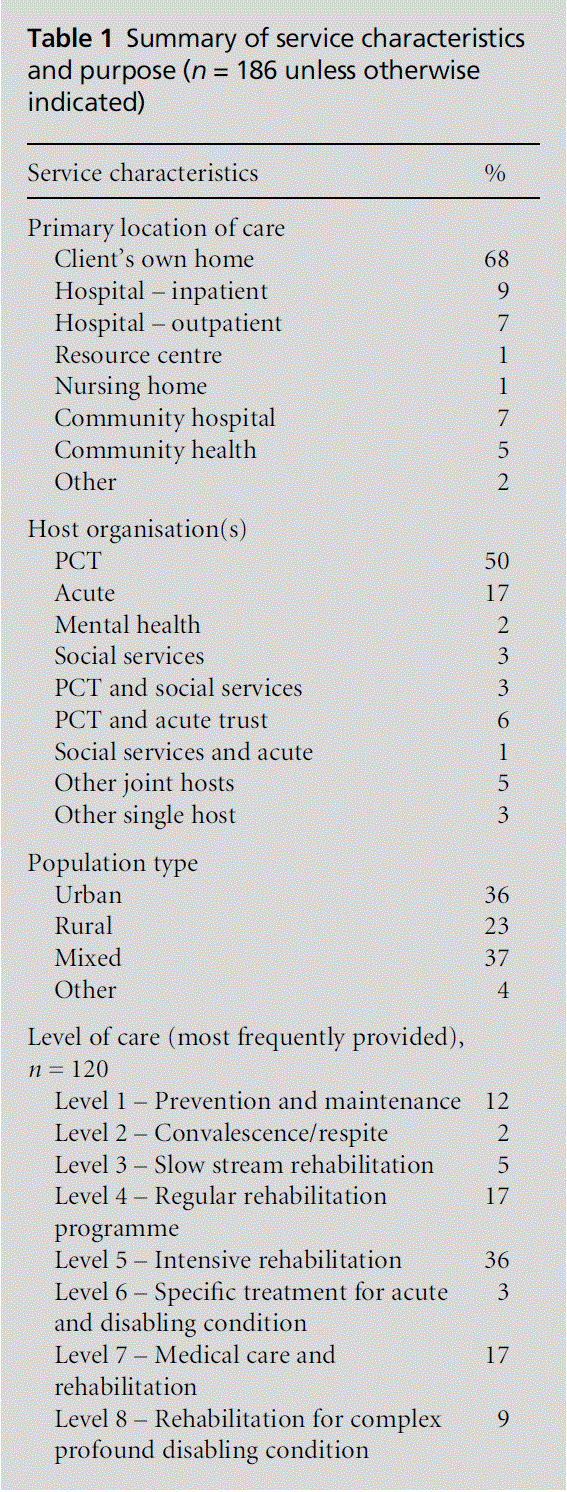
Respondents were asked to rank the levels of care provided by their organisation, from 1 to 8, according to the levels of patient need. The most commonly provided level of care was level 5, ‘Intensive rehabili-tation’ (36%), followed by levels 7 and 4, ‘Medical care and rehabilitation’ and ‘Regular rehabilitation pro-gramme’, accounting for about 17% of patient needs each.
Team organisation
Nurses were the most common team leaders (31%), followed by physiotherapists (18%) and occupational therapists (13%). Most teams (88%) worked from a common team base, and more than half (61%) used a single client file; however, social services used a sep-arate file in the majority of cases (75%). Teams tended to meet monthly (38%) or weekly (31%) for oper-ational meetings. Nearly half (45%) of all teams reported weekly case conferencing. Others met daily (10%), or informally when required (24%) (see Table 2).
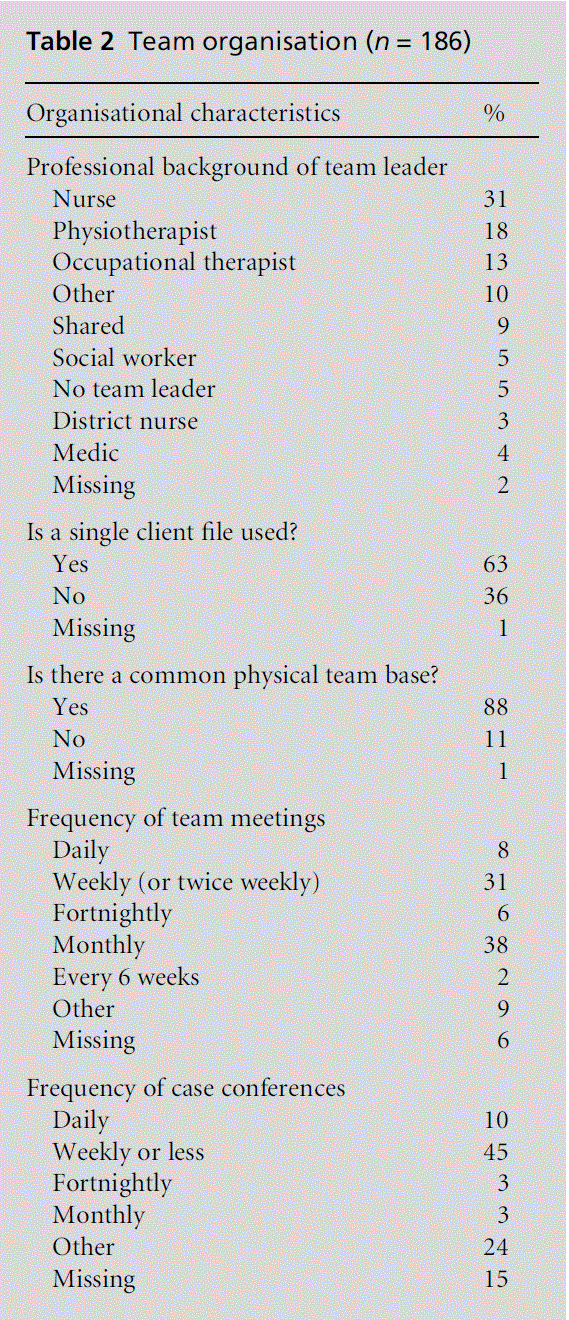
Throughput
Teams accepted a mean of 910.2 referrals (standard deviation (SD) 1331); median 600 (range 20–1300). The number of referrals per year was evenly spread, with 18% of teams accepting fewer than 250 referrals a year, 24% of teams accepting between 250 and 500 referrals a year, 24% of teams accepting between 500 and 1000 referrals a year and 35% accepting greater than 1000 referrals a year.
Staffing
There were extreme variations in staffing across the range of CRAICS that responded to the audit (see Table 3 and Figures 2 and 3). The mean ratio of yearly referrals to whole-time equivalent (WTE) staff (ex-cluding administrative staff) was 66.9 (SD 70.3), median 44.0 (range 2.9–385.4) (see Table 4). The referral to staff ratio did not appear to be associated with the location of care provision (see Table 5).
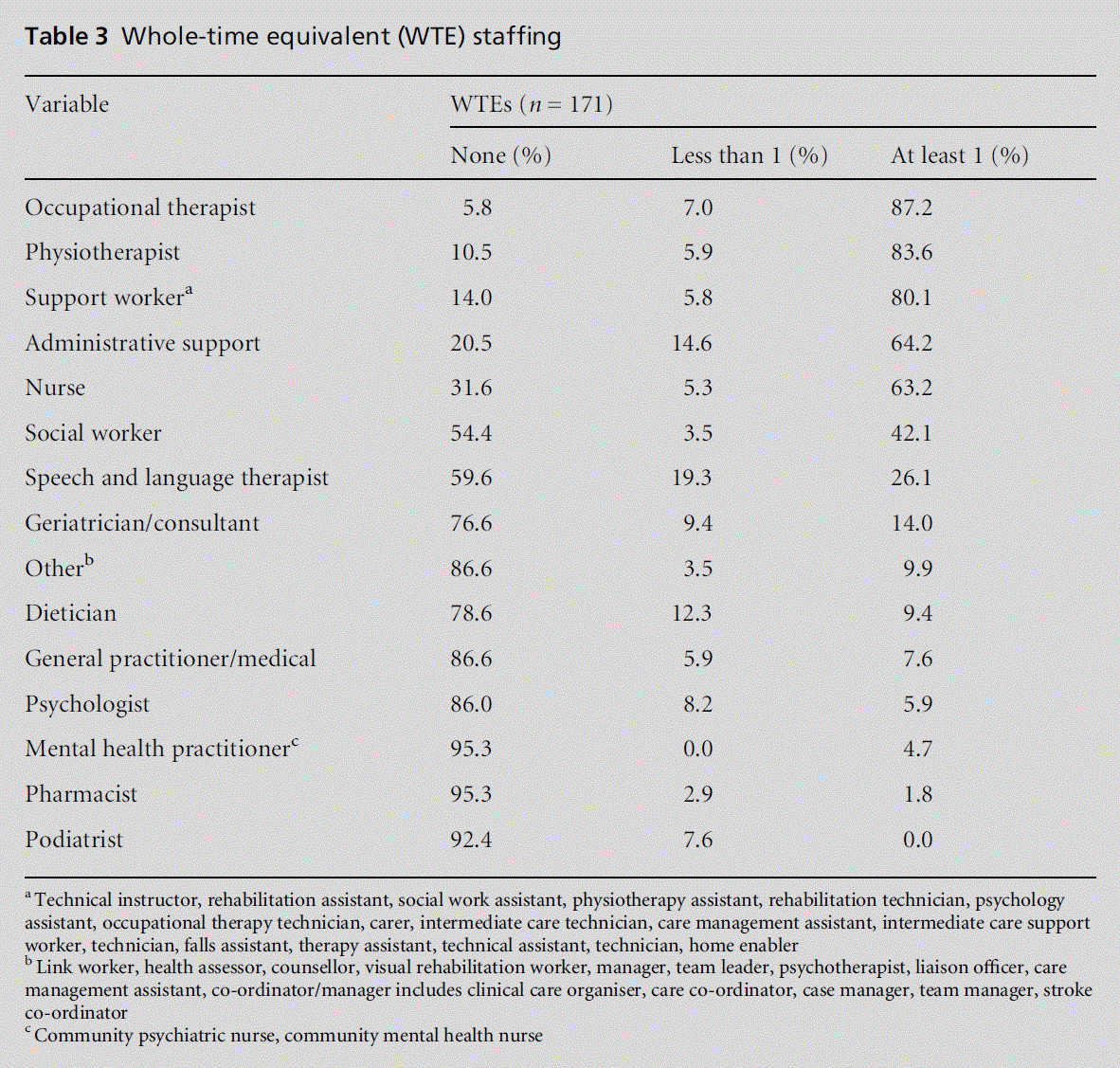
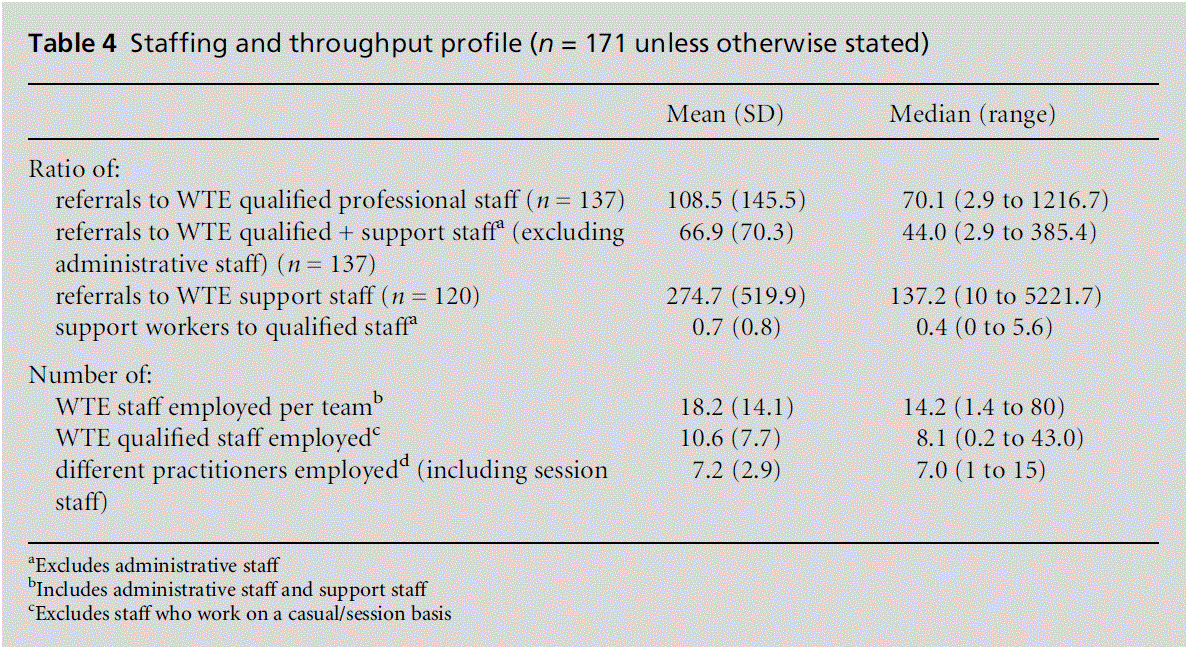
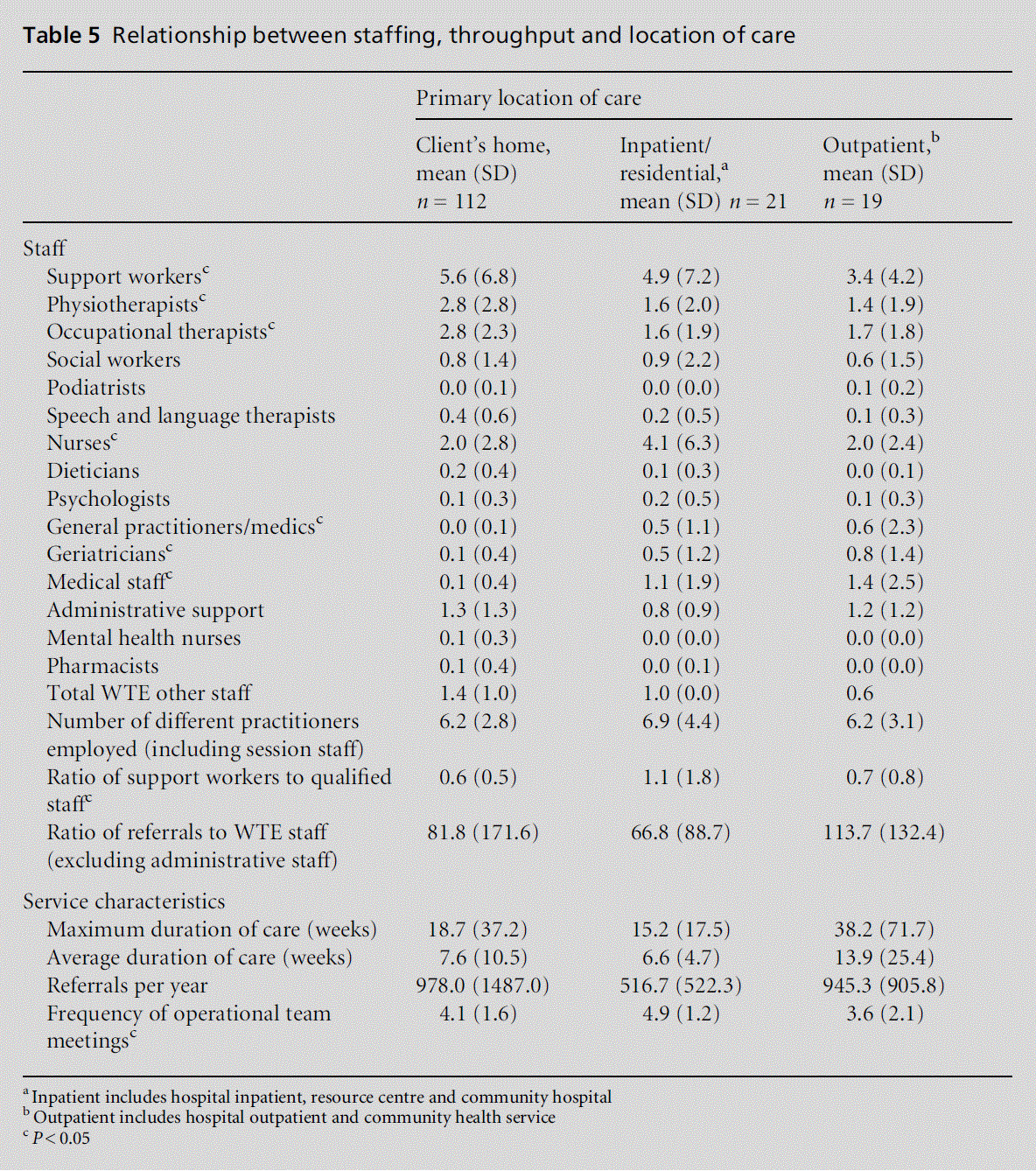
Most services employed at least one WTE occu-pational therapist, physiotherapist, support worker, administrator and nurse (see Table 3). Fewer than half of the teams employed one WTE social worker, speech and language therapist, geriatrician, dietician, psy-chologist or general medical practitioner, and these staff were more likely to be employed on a casual or sessional basis.
There was evidence of variation in staffing accord-ing to the primary setting of care provision. Services delivering care at home reported higher numbers of support workers, physiotherapists and occupational therapists but fewer medical staff (GPs and geria-tricians) (P < 0.05) than inpatient or outpatient ser-vices (see Table 5). Inpatient services reported higher numbers of nurses and a higher ratio of support workers to qualified staff (P < 0.05). Inpatient teams also had more frequent team meetings. Outpatient services reported the highest numbers of medical staff (P < 0.05).
The setting of care was not associated with differ-ences in the duration of care or service throughput. There was also little difference between services in terms of the number of different types of staff that they employed, even though the make-up of that skill mix varied according to the setting of care provision.
Relationships between staffing and setting of care
There was evidence of a statistically significant re-lationship between the level of care provided, whether low (levels 1–3), medium (levels 4–5) or high (6–8), and location of care (home versus outpatient and inpatient): organisations providing medium levels of care were more likely to provide that care in the home rather than at an outpatient or inpatient clinic (see Table 6).
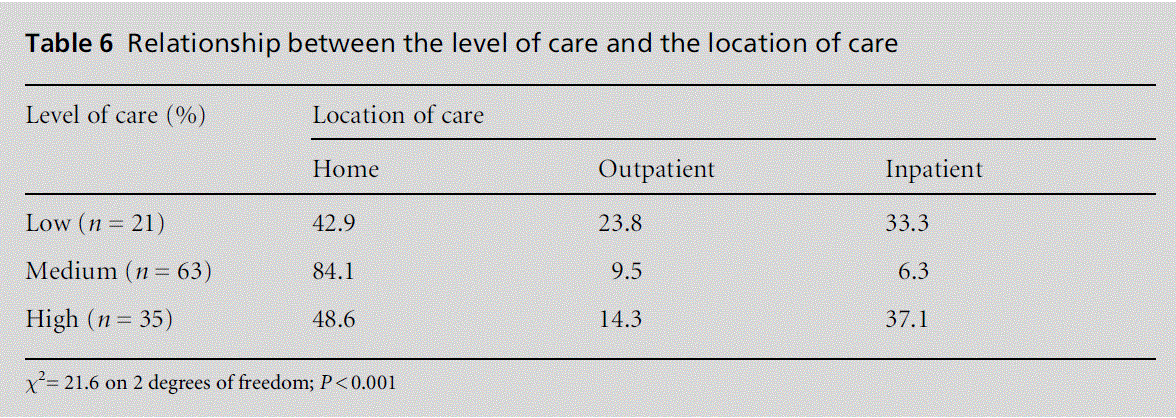
There was a positive association between the num-ber of referrals per year and the number of WTE qualified staff (excluding administrative and support staff) r = 0.555, P < 0.01 (see Figure 2), with the mean number of referrals each year to WTE qualified staff (excluding administrative staff) being 108.4 (median 70.6, range 2.9 to 1216.7) (see Table 5). Similarly, there was a positive association between the number of WTE staff (excluding administrative staff but includ-ing support staff) and referrals s = 0.535, P < 0.01. There was little evidence of a relationship between the number of staff (not including administrative staff) and the size of the population. There was a significant positive relationship between the number of WTE support workers employed and the number of WTE qualified staff employed r = 0.463, P < 0.01.
Cluster analysis
Six variables, considered a priori to be important, were included in the cluster analysis: number of referrals per year, duration of care, number of WTE qualified staff, number of WTE support staff, location of care and level of care provided. This produced two clusters as outlined in Table 7. Cluster 1 only delivered care at home, to patients with medium-level needs. Cluster 2 was more heterogeneous with respect to both location of care and level of care, providing care across the range of these two variables. In addition, cluster 1 received more than twice as many referrals per year and had a lower duration of care. In terms of staffing levels, the number of qualified staff was similar be-tween the two clusters, but what did differ was the number of support workers, which was higher in cluster 1.
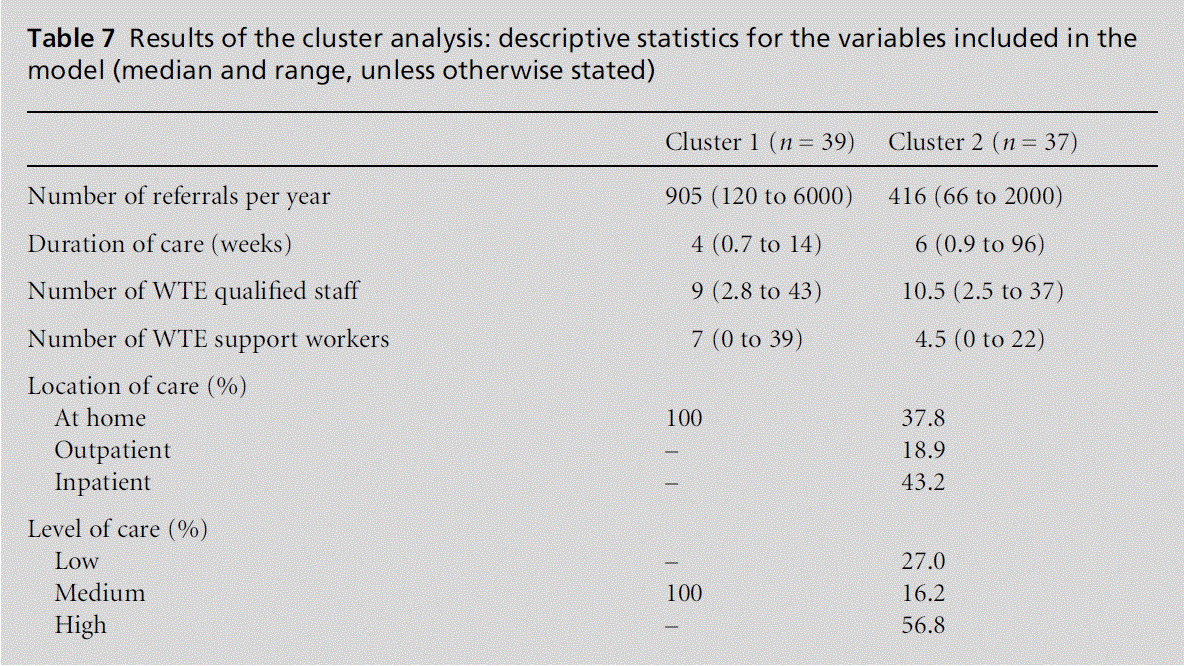
Limitations of the study
Other studies of intermediate care have shown that round 40% of intermediate care services are jointly hosted by health and social services (see Table 8).[11,16]
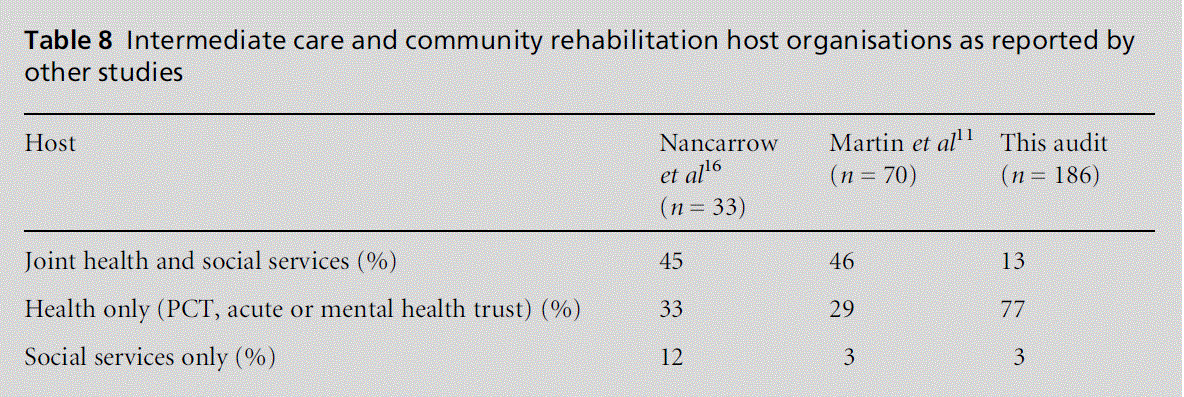
However, this study primarily captured the views of NHS-led services, with only 13% of responding teams being jointly hosted by health and social services. The approach to sampling, in which the CTN network and PCT chief executives were sent the second survey, is likely to account for the large number of health-led organisations that responded to the audit. As a result, it is difficult to determine the generalisability of this audit to all community and intermediate care services.
The response rate to the chief executive survey was lower than that recorded in previous, similar studies.[46] The low response rate in this case may be due to the substantial reorganisation to NHS primary care or-ganisations at the time of the survey.
Staffing
Enderby and Wade undertook a similar survey in 1998/99.[34] Figure 3 compares the staffing profile of the services in 1998/99 with the findings from this study. It is interesting to note that there has been a substantial increase in the numbers of teamsemploying administrators, support workers and nurses, and new roles have been introduced into intermediate care, including social workers, dieticians and pharma-cists. The skill mix of intermediate care, with the emphasis on nursing and therapy staff, implies a focus on physical rehabilitation as opposed to the more social aspects of rehabilitation, although the increase in social worker numbers may indicate a shift in this area. The ‘health’ focus may also be a result of the high proportion of NHS-, as opposed to social services-hosted teams represented in this study.
Levels of care need
The relationship between staff numbers and service throughput, while correlated, is confounded by the different levels of care need. We expected that services with more dependent clients (i.e. medium and high levels of care need) would have a higher ratio of qualified staff to support workers. The cluster analysis (see Table 7) found approximately similar numbers of qualified staff across the two groups; however, cluster 1 had a slightly higher ratio of support workers (care delivered at home to patients with ‘medium’ care needs). Another evaluation that used similar tools found a poor relationship between the level of care needs identified by services and staffing models.[47]
We expected to see a trend in terms of the levels of care need and the location of care, with less dependent patients more likely to be cared for at home, and more dependent clients managed in an institutional setting (hospital, resource centre beds etc). This trend was seen in the low- and high-level care groups (see Table 6), where a higher proportion of patients with low-level care needs were managed at home, and approximately half of the higher-level need services were provided in institutions. However, the ‘medium’ level of care need services showed the highest proportion of home-based care provision, which may reflect the policy trend for deinstitutionalisation.
A limitation of this component of the study was that we asked services to identify, and rank in order, the predominant levels of care needs of clients using their service. This would be more accurate if it were deter-mined through an actual assessment of a series of patients. The results of this audit may also reflect the fact that many services do not target groups with specific levels of need or dependency but see patients with a wide range of needs.
Service throughput
A national evaluation of intermediate care found that the majority of intermediate care schemes had limited capacity, with one-third of services accepting 250 or fewer referrals per year and only 17% taking 500–2000 per year.[48] Our study found greater throughput, with more than half of all teams (59%) accepting 500 or more referrals per year. There is evidence that hospital-based rehabilitation beds have been closed in response to NHS financial reforms,[42] and it is likely that community services have filled the gap left by these closures, which may account for the higher levels of throughput recorded in this study.
Variation
This analysis of CRAICS has highlighted the enor-mous extent of variation in types of services, which have largely been established to address similar needs within the community. Obviously, local contextual variations will influence how these services are formed and delivered. However, the extent of the variation makes comparison between services difficult, present-ing a challenge to identifying models of care that can be described as ‘good practice’ and transferred into other environments. It also challenges attempts to eval-uate CRAICS as an overarching service type, because the variations in staffing, and therefore costs, as well as the approaches to service delivery and organisation reduce the transferability of the findings.
Despite the heterogeneity of CRAICS, most existing studies have found that different schemes demonstrate little, if any difference in patient outcomes. This may mean that there is the potential for efficiency savings through the identification of appropriate staffing models and systems of service organisation, with little effect on outcomes.
This research was conducted as part of a larger study funded by the National Institute for Health Research Service Delivery and Organisation Programme.
Not commissioned; externally peer reviewed.
None.